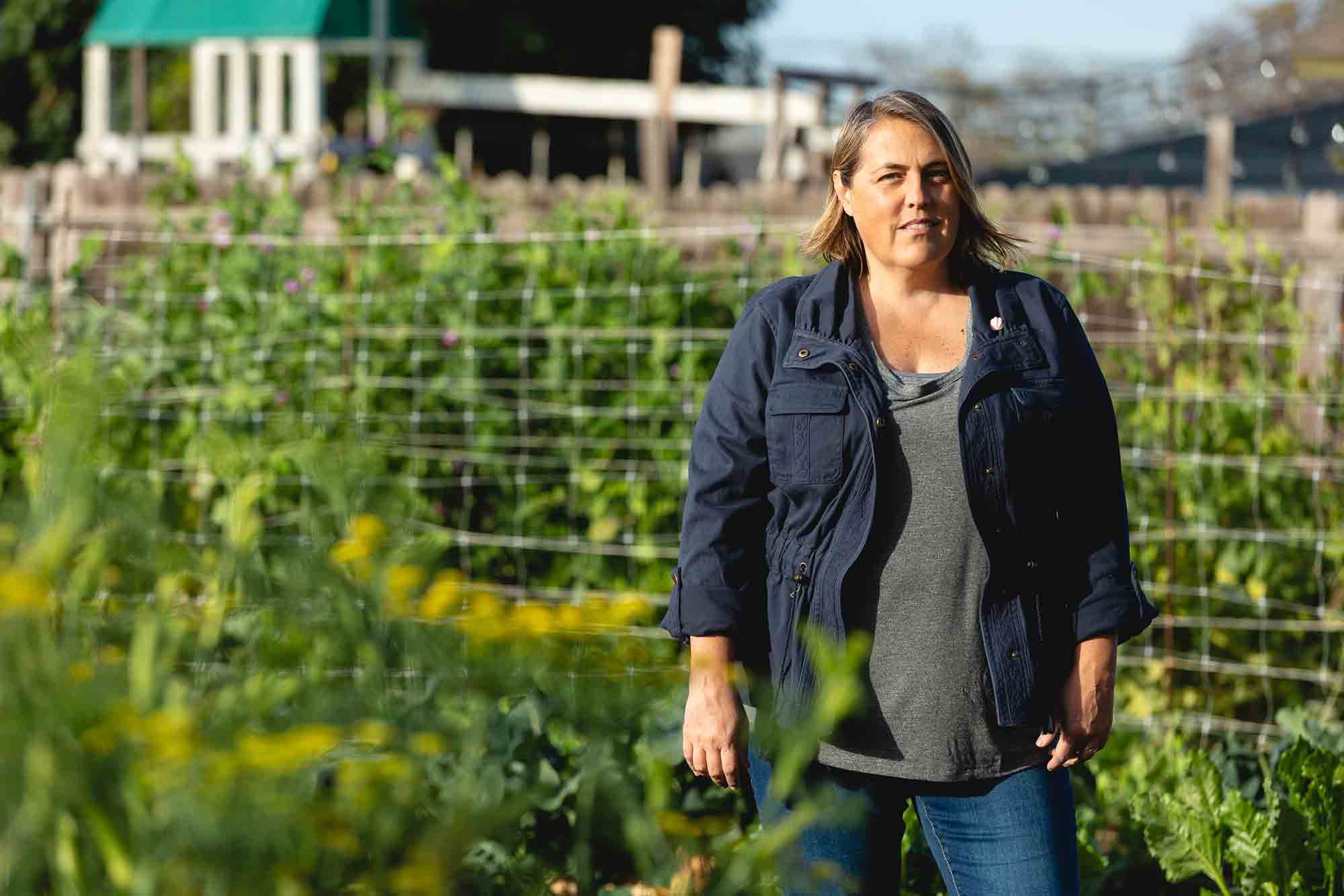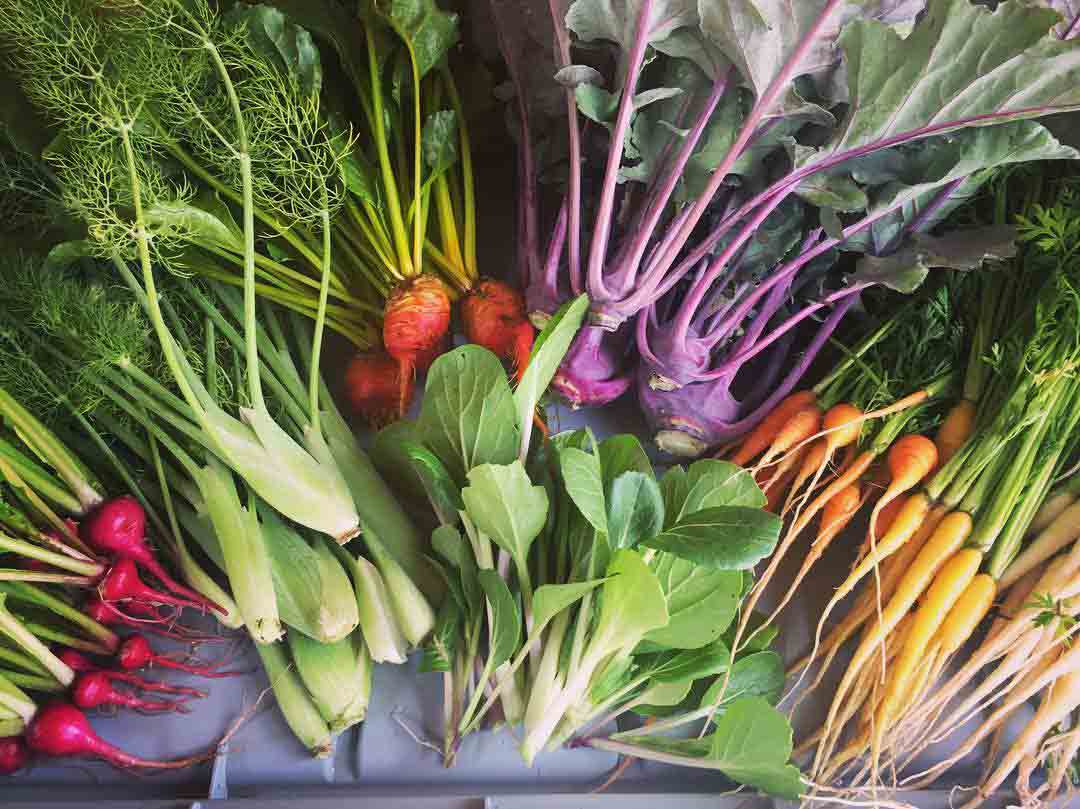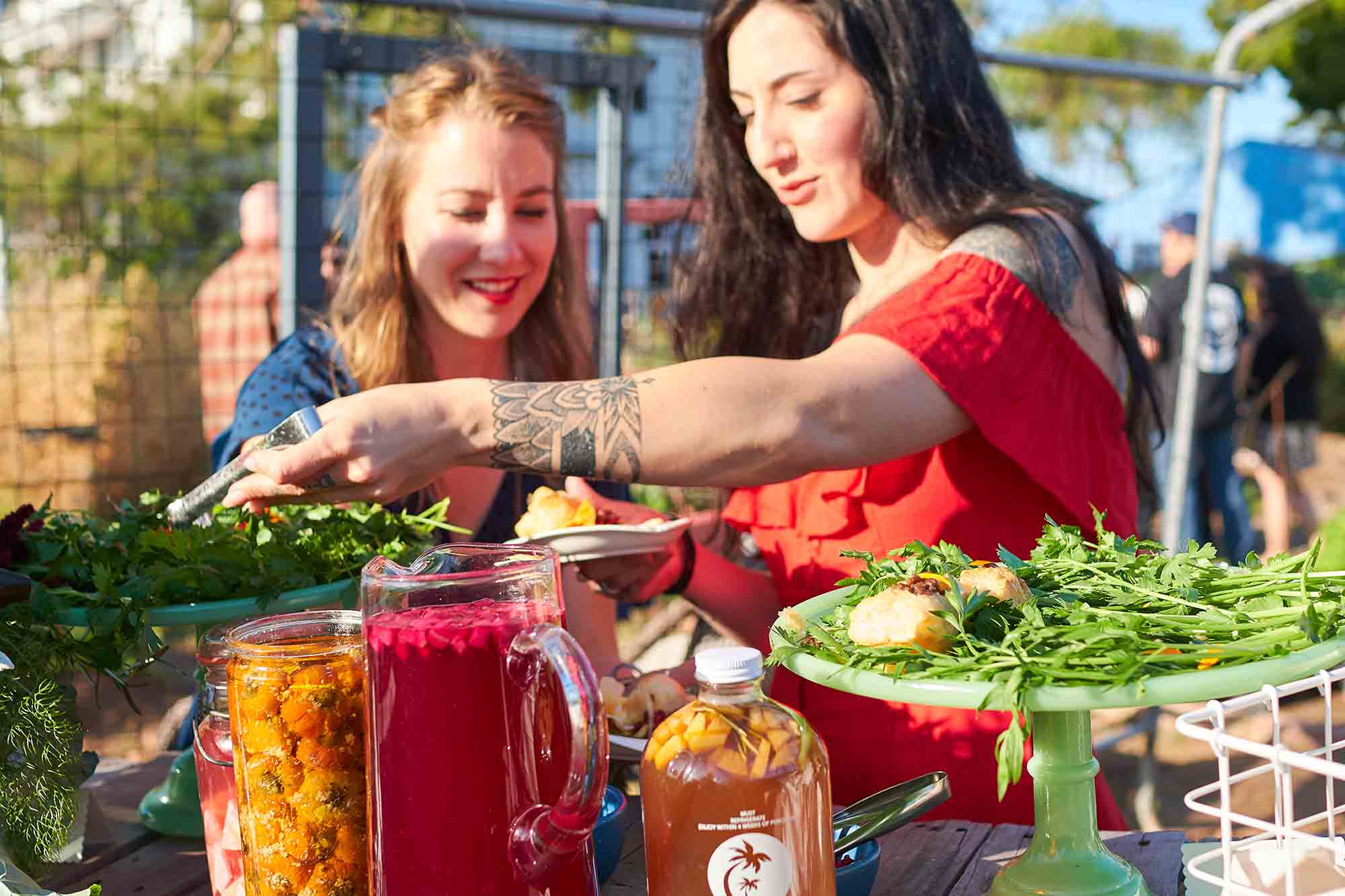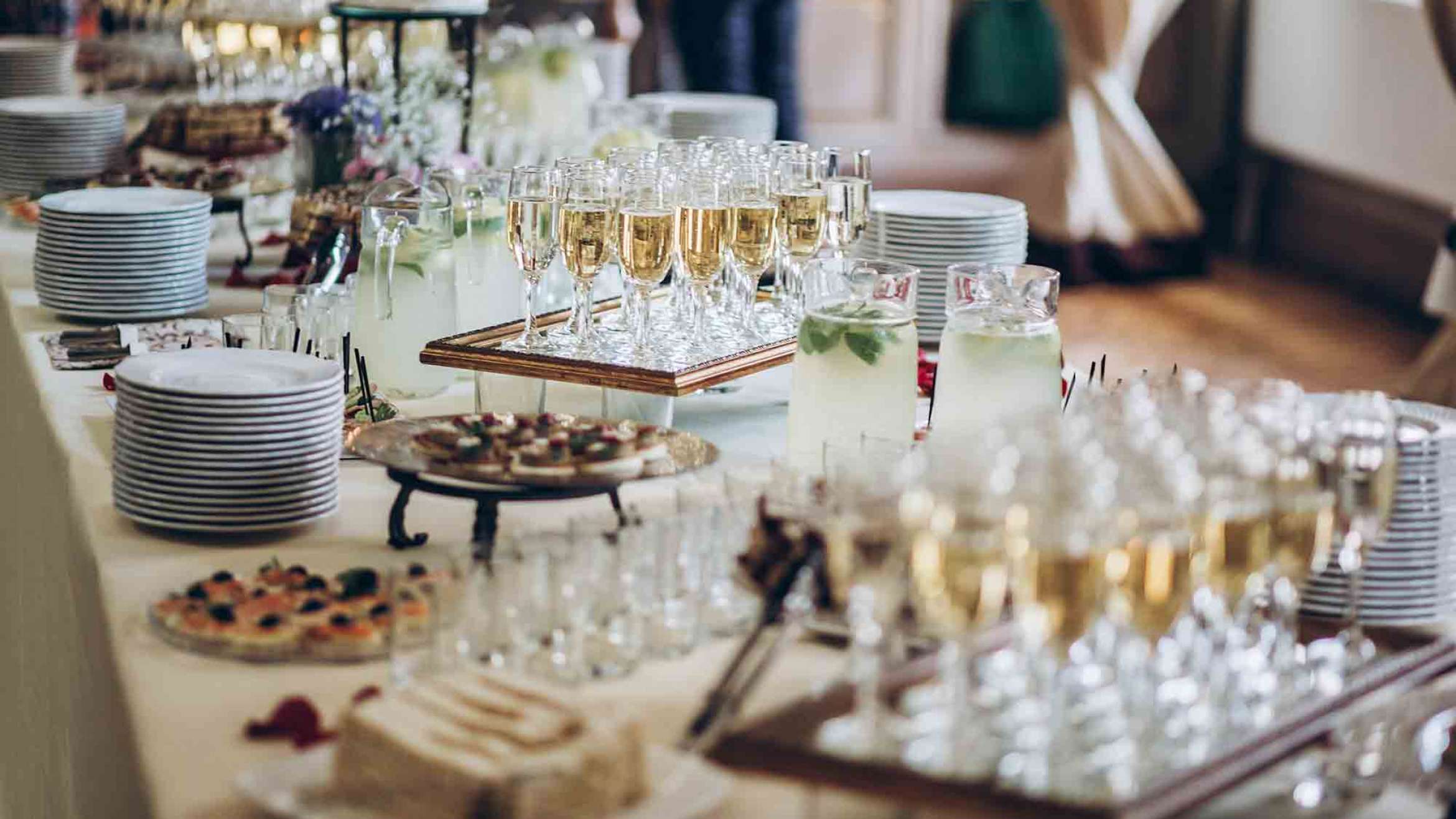Stepheni Norton’s journey from chief yeoman in the U.S. Coast Guard to Southern California community farmer of pre-WWII fruit, vegetables and herbs began with a dream … and an insect bite.
I first met Stepheni Norton at Slow Food Nations in Denver 2017. The event brings together eaters, producers, chefs, families, speakers, writers and, of course, farmers like Stepheni and her husband Mike, who are working to preserve community, local foods, cultures and traditions, and to ensure that everyone has access to good, clean, and fair food. Part of that work is developing the Ark of Taste, an international catalog of endangered heritage foods, and ensuring that these endangered heirloom plants and animals live on today and into the future.
Their farm, The W.D. Dickinson Farm, is “an heir apparent of the Ark of Taste,” she says. Everything they grow has roots going back to before World-War II — some go back as far as 700 years — and 50% of what they grow is in the Ark of Taste catalog. These varietals tend to be locally specific — they are on the endangered list because they may not travel well, or they may taste a little different from what people are accustomed to, or they may not be as “pretty” as what U.S. consumers are used to seeing in their grocery stores. But it’s important to support biodiversity, she says. If you only have a few types of corn, when one crop fails, it’s catastrophic; more biodiversity is the basis for a safer, more secure food system.
Their farm, located in National City in San Diego South Bay, Calif., offers what they call FARMacy CSA, which offers members fruits and vegetables that meet anti-inflammatory, Candida, and diabetic dietary needs. Their farmhouse, which dates back to 1888, is available for events (under normal circumstances, currently sidelined due to the novel coronavirus pandemic), and they hold events of their own to educate and celebrate heirloom varietals.
How did you go from your original career in the U.S. Coast Guard to your current life’s work?
We had this dreamy idea when we first started dating of having a historic home in Southern California that was big enough for our friends and family, with land and a view of the ocean. It was comical, because we knew as a military family we could never afford that. Then we actually found the W.D. Dickinson home, an 1888 Victorian, in 2012, it checked all the boxes in terms of size and structure and location, and it had just shy of an acre of land. It just needed love, to be brought back to life for us and for the community. We look at ourselves as this generation’s caretaker for this property.
Shortly after we bought it, I was bitten by a tick as I prepared for a deployment, though I didn’t know it at the time. I just knew I was feeling sick. The military mentality is, just put your head down and get through it, and so I did. After the pre-deployment workup and a 10-month deployment, I came back so ill that there were days I couldn’t walk or move my body. And we still didn’t know what was wrong.
Most doctors outside of the East Coast really don’t know about Lyme Disease, so it took a couple of years before I was diagnosed with the disease, which by then was at Stage 3, meaning it had breached the blood/brain barrier so I will be living with it the rest of my life. I also had co-infections. We started daily IV antibiotic, antibacterial, and antiviral treatment right away to fight both Lyme and the co-infections. My doctor also suggested I eat a clean diet to give my body a good place to fight the disease from.
My mom used to say, “You have 15 minutes: Scream, cry, kick the floor. Then pull your boots up and get to it.”
And I tried, but I started getting counter-indications for things I had eaten my whole life, like leg cramps and facial tics when I ate corn. I decided to grow my own food, even though it was insane and I had zero experience with farming. My family built raised garden beds I could access easily, since I was having trouble walking and squatting. But I still was having counter-indications, even with the food I was growing myself.
I kept on researching and learned about genetically modified food and highly hybridized food, and how these foods can cause an increased histamine response. For people who don’t have compromised immune systems, it’s probably fine — you may sneeze after you eat something you have a sensitivity to. But I was having pretty significant responses, so in 2014 I thought, what if I try an heirloom variety of just one thing, corn, to see if that makes a difference. At this point, I already knew my corn sensitivities were so bad that we had to have my medicine compounded to ensure there weren’t any corn fillers being used, and I had to stop using makeup. So many things have corn in them!
We babied that first crop of heirloom corn — it was the most cared-for corn in the world! — and when I tried it, I didn’t have a reaction. I tried regular corn again and got a reaction. It may be anecdotal, but it was what worked for me and my body. So we pulled up our other crops and started planning all heirloom varieties, starting in 2015. Even though this was necessary for me from a sensitivity perspective, it’s really amazing food for anyone — the flavors are awesome. There’s no negative to doing this.
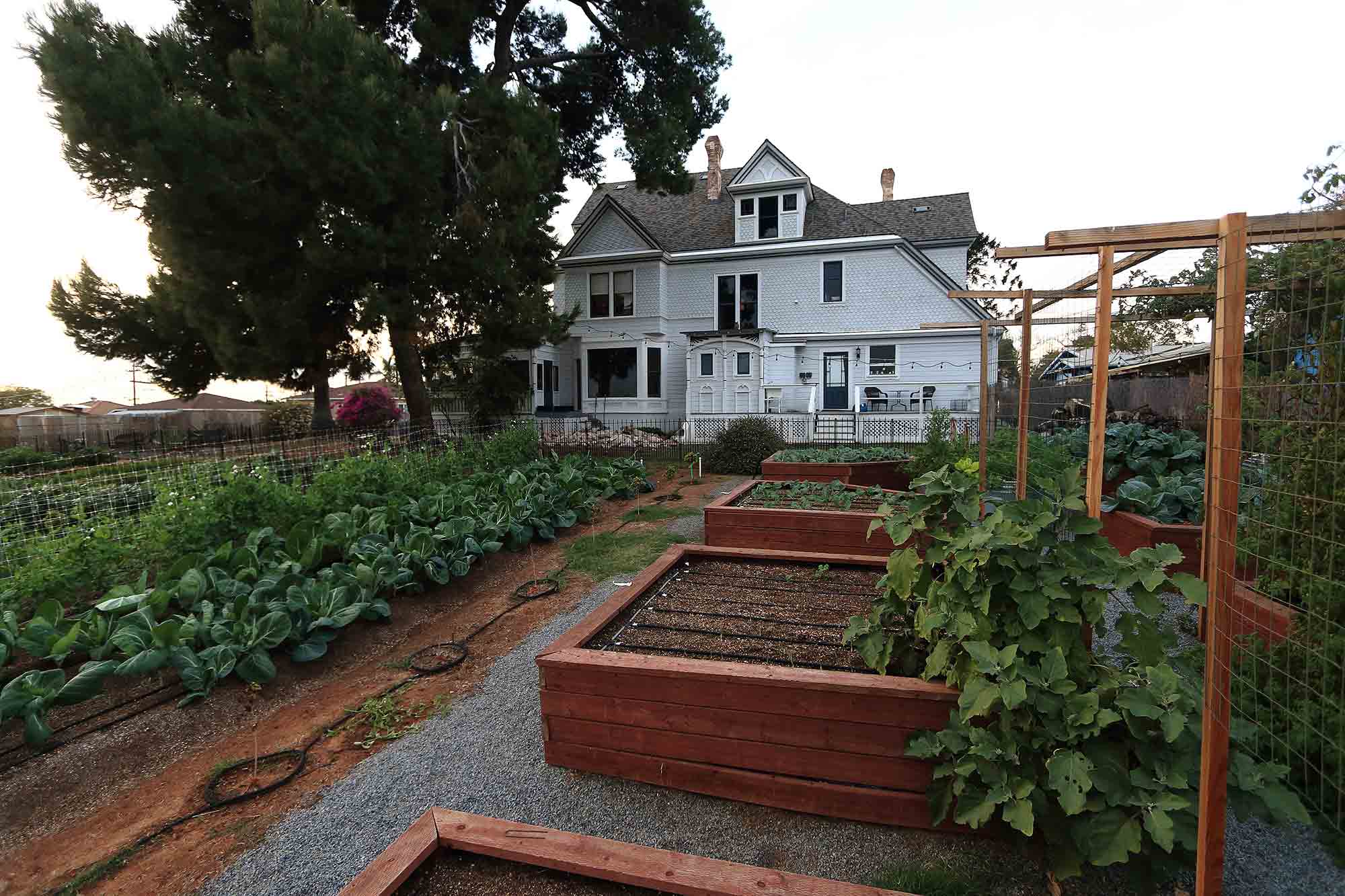
When did you decide to start the community-support agriculture (CSA) piece?
At first, I thought I would just get healthy and redeploy, but then the Coast Guard medically retired me. I had planned on the military being what I did for the rest of my life, so when I found out I was being medically retired, it was like someone hit me over the head with a baseball bat. I couldn’t believe that a bug the size of a pinhead was taking it all away from me. I was in a pretty dark place for a while.
My husband finally said, “Look, you joined the service to serve your country, and now you can do this to serve this community.” And so I took all that energy, good and bad, and literally dug in with a shovel. We figured out how to comply with the regulations and licensing — this is a highly regulated business — and we created a place where we could grow healthy food and get it to the community. And not just our local community, but also the community of people like me who have medical issues.
We now offer a quarterly CSA, timed that way because life for people going through medical treatment can change significantly in a quarter, with six bags over the course of three months. We offer packages that avoid high-trigger items, such as plants with lectins or nightshades in them, and also offer low-sugar items for those with diabetic or Candida dietary needs. We can customize, too.
How does food empower communities and connect people?
I had spent so much time being deployed in the military away from my family and now that I was home, I wanted us to sit down and eat the same foods together, not separate meals at the same table, which feels disconnecting.
We tend toward accommodating the person with the most restrictive needs, but doing it in a way that makes it good for everyone. For example, for our Father’s Day BBQ last year, vegetarians and vegans weren’t left to just enjoy the side dishes. We thought about what we could do to make them feel a part of the community too. We worked with chefs to come up with some amazing alternatives, like jackfruit “pulled-pork” tacos. We need to all stop thinking about what would I like or need and start thinking about how to make it an amazing experience for everyone who comes to the table.
My husband finally said, “Look, you joined the service to serve your country, and now you can do this to serve this community.” And so I took all that energy, good and bad, and literally dug in with a shovel.
A funny story: I have never liked tomatoes. When I was a kid and spent summers in Southern Illinois with my grandparents and my great grandfather, who grew cherry tomatoes. I would want to sit and chat with him, but he’s this old man, and I’m a little kid, and I didn’t know how to talk with him. But I would sit on the porch with him and he would talk about life until we had eaten all the cherry tomatoes off the bush. Food connects us in all kinds of unexpected ways.
What has been your greatest obstacle?
Two pop into my mind. The first was literally navigating what needed to be done to be a certified producer who could sell to the community, knowing all the regulatory requirements. That’s a big issue for the small-farm community. I’m helping the people around me work it out, but I feel like we need a lot more connections and ways to ease through that process to really create food safety and security within our communities.
Also, being someone in the military who traveled so much, I didn’t have much of a community built at home, and it was even harder to connect with my neighborhood because I physically couldn’t be around people due to my compromised immune system.
But one of the things I realized is that, if you are authentically you, with all your stumbles and experiences and perspectives, then others also can be their authentic selves. The community then kind of builds itself.
What words of wisdom did your mother, grandmother, or other women in your life share with you?
My mom used to say, “You have 15 minutes: Scream, cry, kick the floor. Then pull your boots up and get to it.” That is especially good to remember now [with the COVID-19 pandemic] separating families by continents and businesses reeling. Nobody’s saying your emotions are not valid. But shake out the anger, get out the fear that happens when we don’t know what’s around the corner, but then pull your boots up and just see what you can learn from what is in front of you.
What has been important to you as a woman in the food and beverage industry?
Having women as mentors, although they may not think of themselves that way. There are so many women who are juggling a family and creating new methods and recipes, just putting all these amazing things out there. Sometimes we don’t take the opportunity to sit back and say, “I see you. I see how hard this is.” It’s so much better for all of us when we bond together and help each other, rather than compete.
It’s been amazing to be a part of the San Diego community and work with chefs and mixologists and food-and-beverage business owners and see that our struggles are very similar. If you can’t figure something out, there’s somebody who’s willing to say, “Hey, like I hear you. Here’s some stuff that worked for me.”
Who have been your role models and what do you admire about them?
When I was sick, I was reading as much as I could from this random little library full of really odd stuff that people had left behind, including these old cookbooks from the 17th and 18th centuries. I got really interested in old cookbooks and started collecting them and reading about the people who wrote them. And almost all of them were amazing business women of the time! They created cooking schools and educational programs. Women of their time were being told they should just be home and instead they went out and created a structure for other women to learn all these amazing skills so they could open restaurants and be these amazing, game-changing women.
It’s inspirational to see that something as simple as putting a meal on the table is about so much more than eating. It’s bringing people to the table. It’s having the conversation. It’s making change.
What do you look forward to in your work and the food and beverage industry overall?
I would if you asked me two weeks ago, I would have had a different answer, but right now I actually really look forward to seeing the amazing pivots that are coming out of what we’re going through [during the COVID-19 pandemic].
We’re not all just shutting our doors and walking away and hiding. We’re asking how can I still support my community? How can I still support my customers who look to us what they need? It’s the restaurant that’s starting a new delivery service that they never thought they would do.
It’s the farms that are starting a CSA for the first time, or a farm stand.
What advice would you give to a young woman who is just starting out in the food and beverage industry?
Sit back. look. Listen a lot. Be willing to think outside the box, but also been willing to look historically at the women who came before us. There’s so much to learn from our ancestors.
What do you most appreciate about what you do?
I appreciate that after spending so much of my adult life traveling around the world, I’m finally home. That means a great deal to me. This farm calls out to me. There are things it needs. There are things I need to learn from it. And that’s something that I have the opportunity to do every day.
I appreciate that I have the opportunity to employ people and give them a place that they can learn and grow and contribute.
I really appreciate my community. I’ve been given the opportunity to participate in an industry that was never even on my radar, and I’m honored to be a part of it.
What is your favorite food, and why?
My absolute favorite food is really good corn. There was a point where I thought I could never have it again, and I have so many memories I would have had to walk away from, of making cornbread with my grandmother, and getting nachos and tacos and tamales with my close college friends. I know it seems like a really odd choice, but it is heartfelt.
If you could have anyone in the world over for dinner, who would you invite?
I would have both of my grandmothers and my mother. They have all passed, and I would love to just sit down with them and show them everything that has occurred in my life and our home and make a meal just for them.


